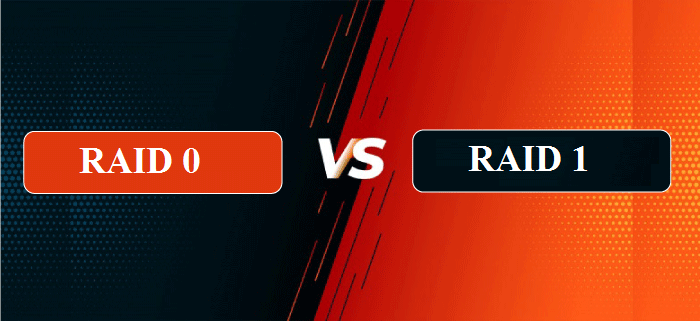Difference between RAID 0 and RAID 1RAID is a collection of disk organization techniques that are developed to address reliability and performance. The main distinction between RAID 0 and RAID 1 is that RAID 0 does not include redundant data and instead uses striping. In contrast, RAID level 1 employs mirroring and contains redundant data. RAID was initially shortened as redundant discs of inexpensive disks as it was designed to provide huge disk storage at a cheap cost by using several inexpensive disks. Although today, this technology offers large disk volumes and high data rates, fast access, and dependability. In this article, you will learn about the difference between RAID 0 and RAID 1. But before discussing the differences, you must know about RAID 0 and RAID 1 with their advantages and disadvantages. What is RAID 0?RAID 0 is an abbreviation for the "Redundant Array of Independent Disks level 0". RAID 0 organizes data by interleaving it across many disks, often known as RAID level 0. As a result, the disk is accessed in parallel while conducting an I/O operation. Generally, RAID level 0 is not a RAID organization because it contains no redundant data. It employs the disk striping technique. Disk striping is a method of dividing a drive's storage space into stripes ranging in size from 8KB to 1024 KB. These stripes are included in a repeated sequence manner. Strips from every drive produce integrated storage space. Even though RAID 0 only allows for one drive, data can be written to several drives. Strip size refers to the portion of a stripe that is stored on a single drive. For instance, a stripe contains 48 KB of disk space and 16 KB of data remaining on eve rydisk in the stripe. As a result, the stripe size is 48 KB, whereas the strip size is 16 KB. When n disks are utilized and placed under a separate disc controller, RAID level 0 delivers an 'n' time boost in transfer rates. Although, it has some drawbacks, such as data may not be accessed even if a single disk fails. Furthermore, a lack of redundancy may result in data loss. Advantages and Disadvantages of RAID 0There are various advantages and disadvantages of RAID 0. Some main advantages and disadvantages of RAID 0 are as follows: Advantages
Disadvantages
What is RAID 1?RAID 1 is an abbreviation for "Redundant Array of Independent Disks level 1". RAID 1 setup used data mirroring, where identical data is stored on two different disks. During a read operation, the data from identical data that can be retrieved more quickly is used. Parallel readings are also possible when no errors are made. When a process updates or writes a record, one copy of the record is written to each disc. As a result, RAID level 1 has 100% overhead. In the event of a disc failure, only one copy of the record is guaranteed to be available. Mirroring techniques improve fault tolerance. Advantages and Disadvantages of RAID 1There are various advantages and disadvantages of RAID 1. Some main advantages and disadvantages of RAID 1 are as follows: Advantages
Disadvantages
Key differences between RAID 0 and RAID 1
There are various key differences between RAID 0 and RAID 1. Some of the key differences between RAID 0 and RAID 1 are as follow:
Head-to-head comparison between RAID 0 and RAID 1Here, you will learn head-to-head comparisons between RAID 0 and RAID 1. The main differences between RAID 0 and RAID 1 are as follows:
ConclusionRAID level 0 is not considered a RAID because it has no redundant data. RAID 0 is appropriate when faster data access is required. In contrast, RAID 1 contains redundant information and is appropriate when the emphasis is on data availability. RAID 1 is the preferred solution if the data is vital and cannot be interrupted by hardware failure. On the other hand, if you require faster data throughput, RAID 0 is the superior alternative.
Next TopicDifference between
|
 For Videos Join Our Youtube Channel: Join Now
For Videos Join Our Youtube Channel: Join Now
Feedback
- Send your Feedback to [email protected]
Help Others, Please Share










